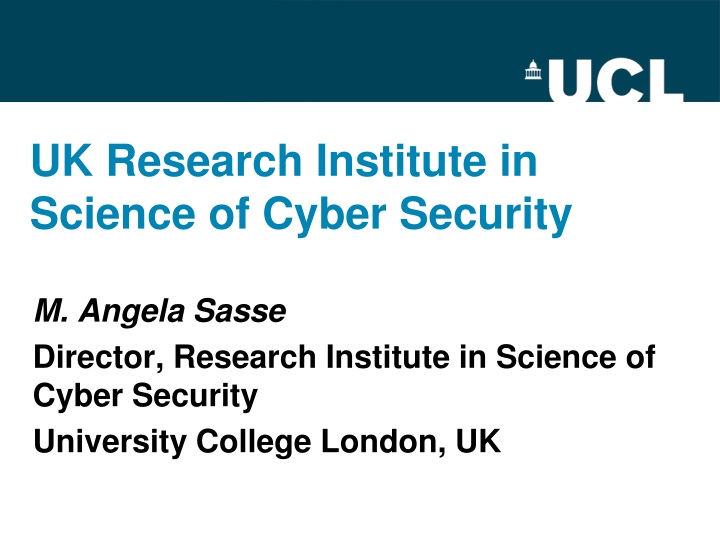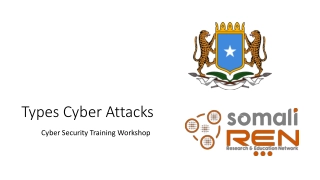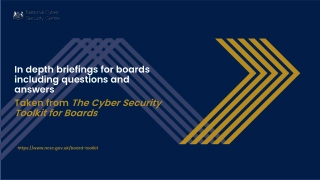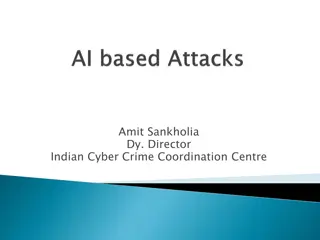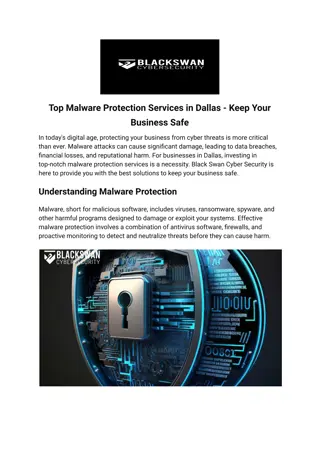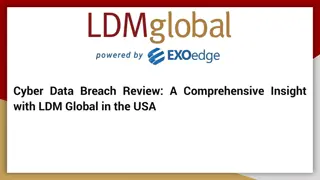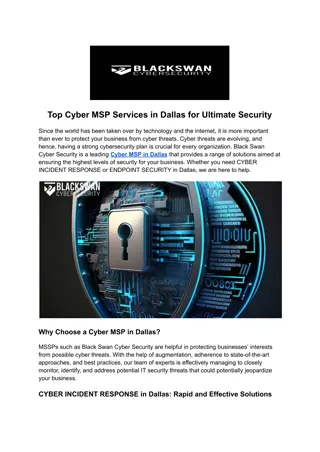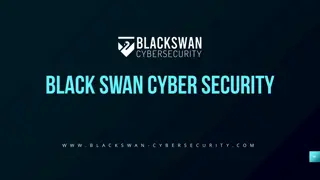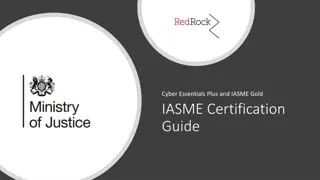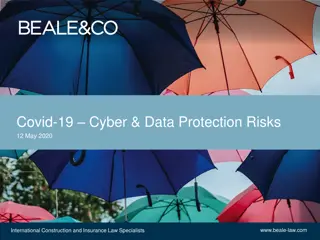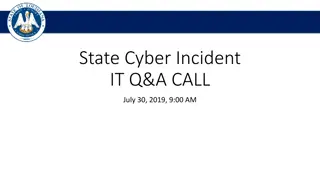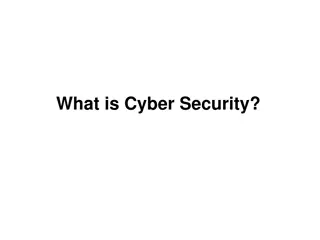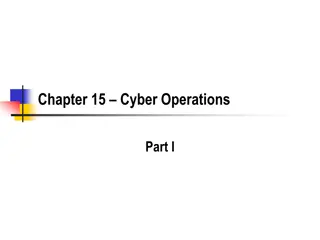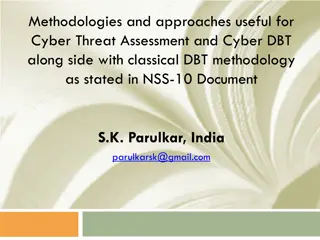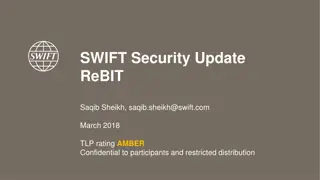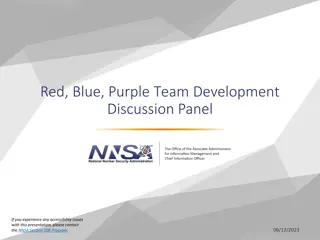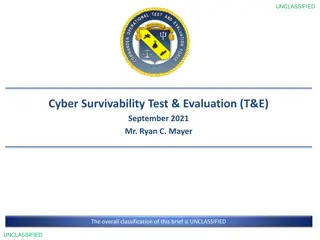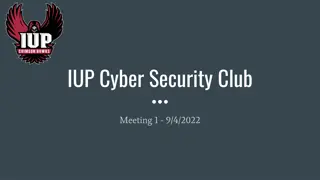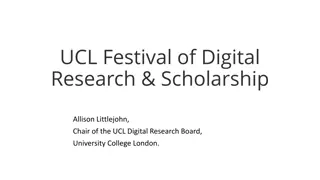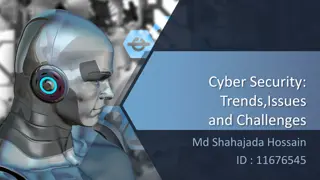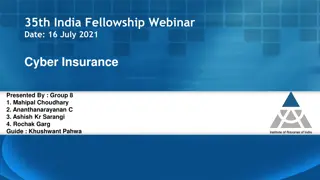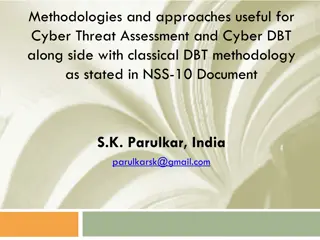Research Institute in Science of Cyber Security - UCL, UK
Conduct cutting-edge research in the field of cyber security, led by Director M. Angela Sasse at University College London, UK. The institute focuses on advancing knowledge, developing solutions, and enhancing understanding of cyber threats and defenses to protect individuals and organizations from digital risks.
Download Presentation

Please find below an Image/Link to download the presentation.
The content on the website is provided AS IS for your information and personal use only. It may not be sold, licensed, or shared on other websites without obtaining consent from the author.If you encounter any issues during the download, it is possible that the publisher has removed the file from their server.
You are allowed to download the files provided on this website for personal or commercial use, subject to the condition that they are used lawfully. All files are the property of their respective owners.
The content on the website is provided AS IS for your information and personal use only. It may not be sold, licensed, or shared on other websites without obtaining consent from the author.
E N D
Presentation Transcript
UK Research Institute in Science of Cyber Security M. Angela Sasse Director, Research Institute in Science of Cyber Security University College London, UK
Background: Cyber Security research in the UK 2011: UK Cyber Security Strategy 2012: 8 Academic Centres of Excellence in Cyber Security Research: Belfast, Bristol, Lancaster, Imperial College, Oxford, Royal Holloway, Southampton, UCL Research Institute in Science of Cyber Security, 2012 Centre for Capacity Building in Cyber Security announced 2013: 2 Centres for Doctoral Training in Cyber Security
UK Research Institute in Cyber Security Funded by GCHQ in partnership with the Research Councils Global Uncertainties Programme (RCUK) and the Department for Business Innovation and Skills (BIS) 3.8 M over 3.5 years Virtual Institute 4 projects involving 7 universities coordination activity (Research Director Angela Sasse)
Goal of the RI allow leading academics in the field of Cyber Security from across the UK to work together to connect them with the collective expertise of industry security experts, and international researchers most emphatically multi-disciplinary research Science of Cyber Security
Here comes the science bit 1. How secure is my organisation? 2. How do we make better security decisions? Evidence-based: Establish a map of substantive, empirically-based knowledge, and fill the gaps Identify/develop a set of suitable methods for cyber security research, and for companies Shift from craft to science
Looking forward Push for more cross-Atlantic collaboration Joint projects Particularly: projects involving companies that operate in both the US and UK Internships, exchange of Doctoral Students Establishing A multi-disciplinary Science of Cyber Security Conference first in London 2013 A high-quality Open Access Journal Companion publication for decision-makers
Project: Cyber Security Cartographies Partner: Royal Holloway, University of London (Dr Lizzie Coles-Kemp & colleagues) Aim: explore how a security manager develops, maintains and uses visibility of both social and technical asset compliance behaviors for the management of cyber security risks
The scenario There is of course continuous pressure to extend BYOD (bring your own device to work) access across our estate and we are struggling to achieve an architecture which will allow us to deploy popular applications like Outlook Web Access for 3rd party devices whilst still achieving 2FA and without impinging on the integrity of our service platforms not so much because of the technical challenges of slicing and dicing security configurations in vmware etc., as trying to second guess how the business and our other tenants will appropriate the processes we encourage them to implement. Conn Crawford, Sunderland City Council
The research questions 1. How does a security manager know when to combine specific technical, physical and organizational controls? 2. How does a security manager differentiate between effective and ineffective control combinations? 3. How does a security manager influence the appropriation of controls, and what makes this influence effective? 4. Does the use of visualizations affect a security manager s ability to select effective control combinations?
Expected output 1. A method for combining and evaluating combinations of technical and organizational security controls 2. Methods and design principles for visualizing and analyzing combined organizational and technical compliance behaviors 3. Use cases and case study reports
Project: Games and Abstraction for Cyber Security Partners: Imperial College London (Prof. Chris Hankin) Royal Holloway, Unversity of London (Prof. Dusko Pavlovic) Queen Mary, University of London (Dr Pasquale Malacaria)
Our Proposition Game Theory can help Systems Administrators make better decisions about how to defend their systems. The Cyber Security Problem can be seen as a two player game consisting of an Attacker who wants to maximise damage and a Defender who wants to minimise downtime and protect resources. For example, once an http server has been compromised the likely next steps of the attacker would be to deface the website or install a sniffer. Defences include re-installing the compromised account or installing a sniffer detector. Attackers are far more likely to just deface the website and so the best defence is therefore to re-install the compromised account. We have designed a scientific programme to make this kind of analysis a robust and tractable problem.
The Approach Stochastic Game Theory has been studied as a basis for decision support systems for cyber security for about 10 years. For example, even quite simple systems: are intractable this example has over 4 billion states. E is the environment, W is a web-server, F is file server and N is the collection of networked computers
The Approach, contd... Previous work takes an ad hoc approach to ignoring detail. If we abstract, what happens to the equilibria, etc? what is the justification for making operational decisions on these simplified models? Abstract Interpretation a technique for abstracting program behaviours, used in program verification - provides a systematic approach.
Refinements In order to deal with Incomplete games (where the players do not know each others strategies), we will combine machine learning with abstraction. Games with imperfect information arise when players do not know each others state we will develop a model that can deal with such situations.
Expected outcomes 1. New theory and understanding of game theory and its application to cyber defence. 2. Proof-of-concept implementation of a decision support tool based on adaptive, imperfect information stochastic games with intermediate results relating to simpler systems. 3. Empirical evaluation of the implementation against data sets from real stakeholders. 4. Policy advice on cyber security strategy.
Project: Choice Architecture for Information Security Aims: How to achieve strong cyber security decisions and operations Partners: University of Newcastle (Prof. Aad Van Moorsel) University of Northumbria (Prof. Pam Briggs) 17
Bring-Your-Own-Device (BYOD) BYOD: higher productivity but with risks: losing it in the train the children use it too can we nudge employees to exhibit effective security behaviour? [ Image: DigitTrends ] 18
Choice Architecture for Information Security How to achieve strong cyber security decisions and operations? No Spy Apps Choice Architecture Biases Inhibit User decision Encrypted Storage Ensure Encourage Free Choice Loss Handling Operational Policy Bring-Your-Own-Device (BYOD) 19 [ Image: DigitTrends ]
Choice Architecture for Information Security How to achieve strong cyber security decisions and operations? Work plan: 1. use HEFCE/JISC Iridium findings about data use (iridiummrd.wordpress.com) 2. gain understanding in the psychology of ownership and citizenship 3. establish quantitative decision models (leading to nudging ) 4. apply to Iridium and SME case studies BYOD [ Image: DigitTrends ] 20
Project: Productive Security Partners: University College London (Prof. Angela Sasse) University of Aberdeen (Prof. David Pym) Aim: to assist information security decision- makers in with science to make better choices for both their organization s security and productivity
Hypothesis: Cause of non-compliance 10% Staff who think they know better, or don t care Staff who know what they should do, but feel they can t comply without failing their job responsibilities 80% Staff who don t know policy 10%
Empirical studies Multi-national energy company wishing to change security culture 118 semi-structured interviews with staff on (non)compliance, to identify areas and reasons Online survey asking staff about security behaviour and attitudes 1256 valid completed survey 800+ free text responses
Interview Results Good awareness of corporate security policies But: every single interviewee reported not complying with at least one policy Hotspots include bypassing access control, not encrypting files, password sharing, tailgaiting Main drivers for non-compliance Time and performance pressures Compliance impossible - inconvenient Compliance would damager individual/business performance
Survey of staff behavior and attitudes 10 scenarios describing employee having to make a decision about compliance Each employee presented with 4 scenarios clear company policy, but no easy answers dilemma between business and security range of non-compliant options to deal with dilemma participants ranked the options in order of preference rated severity of security issue created by non- compliance in each scenario
Jason is an XY Commercial Analyst and is currently involved in an important project that requires him to present progress updates to clients, often in offsite locations. He would normally use his laptop to take presentations to clients, but his laptop developed a problem and is currently with maintenance. He decides to use an encrypted USB memory stick to transfer the required files to the client site. Shortly before he is due to leave for the meeting, Jason realises he lent his encrypted USB stick to a colleague. He knows he will not get a replacement at such short notice, but needs some way to transfer information. The presentation includes embedded media and is too large to email, and he cannot access the internal network from the client s site.
Option A: Take the required data on an unencrypted USB stick - you have one to hand. Option B: Borrow an encrypted stick from a colleague. You would have to also make a note of their password so you can access the data at the client's site. The colleague had asked that you do not share / erase the confidential data already on the stick. Option C: An employee of the client has been visiting XY and is due to travel back with you. Use the available unencrypted USB stick to put a copy of the data onto their laptop and ask them to take it to the client's site. Option D: Upload the files to a public online data storage service and recover them at the client's site.
Behavior Types Type 1: Least compliant disregard policy to maximize productivity in case of any friction Type 2: Partly compliant - condone insecure behavior in case of friction, expect others to take care of security Type 3: Largely compliant try to comply, but occasionally prioritize productivity over security; prepared to take action if cost to themselves is low Type 4: Mostly compliant try to put security first, prepared to take action themselves Most frequent behaviour types were 3 and 4
Attitude types Type 1: Discount suspicions, cause no bother, passive Type 2: Report suspicions if easy to do, take no direct personal action Type 3: Report suspicions through prescribed channels, take no personal direct action Type 4: Take direct personal action against the threat Most frequent attitude types were 2 and 3
Analysis of free-text responses Overwhelming number suggested more secure workarounds (alternatives to options offered) but 99% of suggestions were not secure Large number of justifications for workarounds Less than 10% mentioned benefits of security policies and mechanisms
Managing Non-Compliance Compliance requires ability and willingness Can t comply, won t comply Security asks that are impossible to complete. Must remove security hygiene Could comply, don t comply Tasks that can be completed in theory, but require high level of effort and/or reduces productivity. Re design or SEAT Can comply, do comply Security tasks that are routinely completed. Provide initial baseline.
Way forward participating company 1. Security hygiene Staff encourage to report workarounds Security staff discuss with line management and respond with action plan 2. Targeted security awareness, education and training Max. 3-4 priority policies at the time Different messages to different business areas and job roles 3. Repeat measurements - also of productivity
and with the science bit accompany with field and lab measurements of actual effort expended on security build database of actual effort Developing measurement toolbox for measuring perceived effort Modeling the cost and benefits of changes for risk management and productivity Develop decision-support tool for security decision-makers
